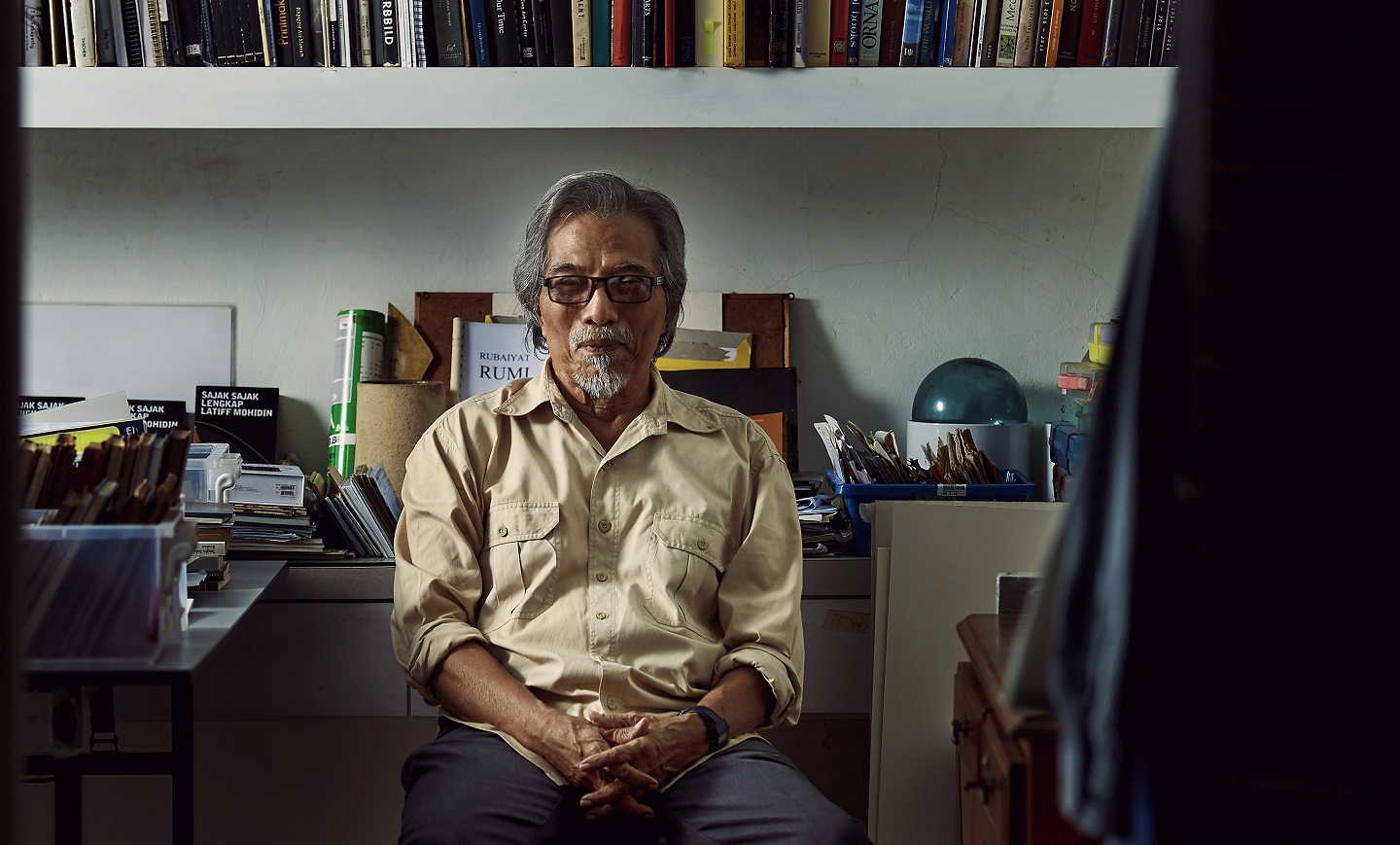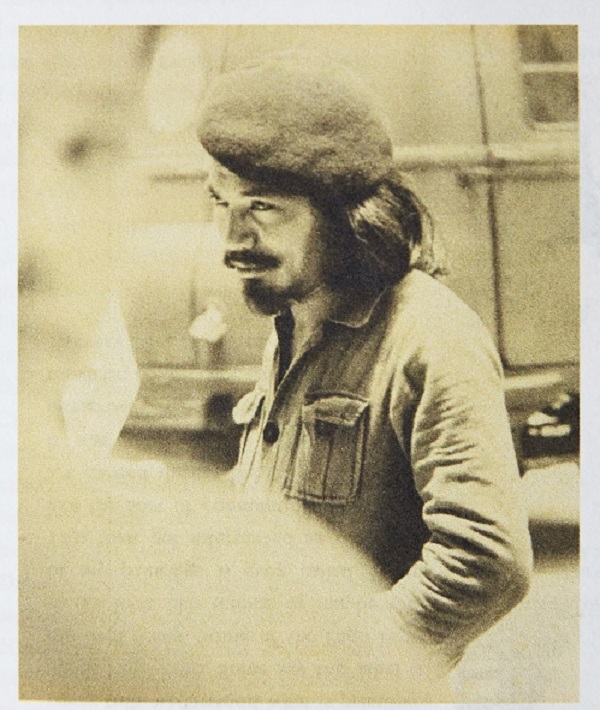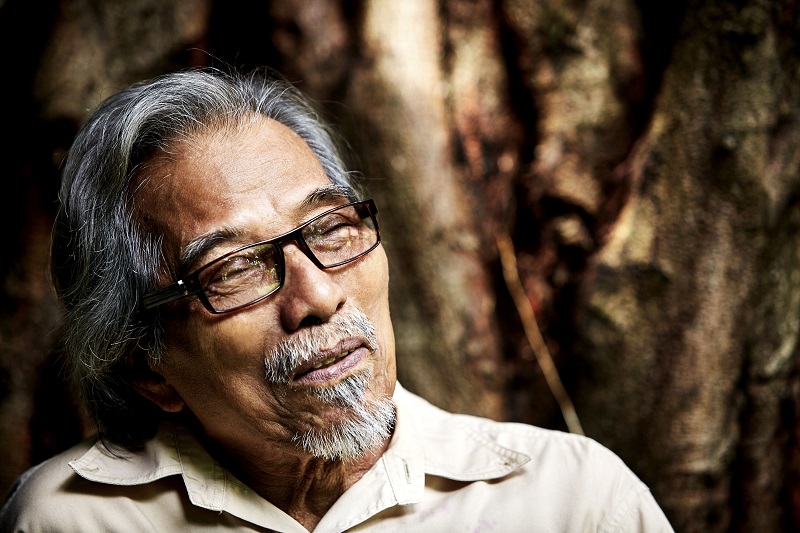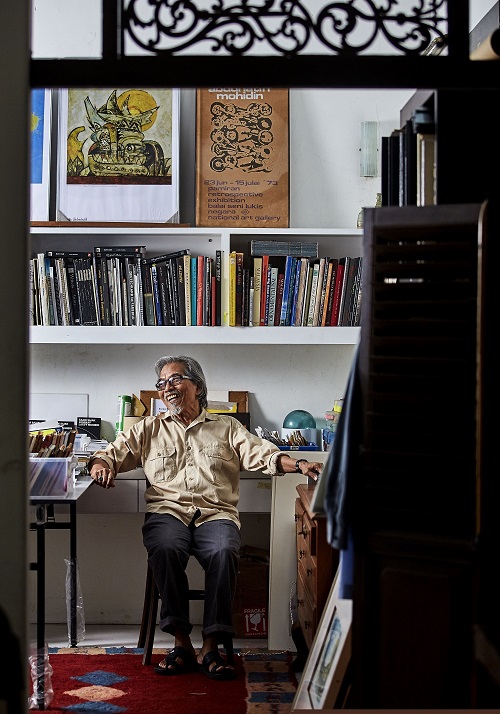
(Photography by SooPhye/Options)
Latiff Mohidin has been known by many names. When young, he was hailed as the “boy wonder” and “the magical boy with the gift in his hands”, for his unmissable prodigious talent. In fact, he was just 11 when he sold his first work, a painting of a brinjal, to Sir Malcolm MacDonald, the then-British High Commissioner to Singapore. Later, Latiff became known as “Malaysia’s Picasso” for his sheer virtuosic ability to transcend mediums (this leading modernist painter is also an accomplished sculptor and poet) and, essentially, stay at the peak of his creative game for what has been decades now.
Now, at the age of 77, the boy-wonder-turned-legend has pulled yet another ace from his sleeve as he will be the first Southeast Asian artist to be featured at the Centre Pompidou’s In-Focus Gallery at the upcoming Latiff Mohidin: Pago Pago (1960-1969) exhibition, to be held from Feb 28 to May 28. The significance of this exhibition cannot be overrated as it will also be the National Gallery Singapore’s first travelling exhibition on Southeast Asian Art — the happy result of success in the gallery’s efforts and commitment to promote regional art on the global platform. Those who have visited the City of Light would also know of the Pompidou’s iconic design and how it houses one of the world’s two most important collections of modern and contemporary art which, if counted, number over 120,000 works.
Nature's Child
Exceedingly gentle and soft-spoken, Pak Latiff, as he likes to be called, was certainly all smiles when we paid him a congratulatory visit at his beautiful home in Penang. Ever gracious and modest, he says: “I felt honoured and humbled when I received the invitation to show at the Pompidou. I am still a bit overwhelmed, to be honest,” he admits when we sit down to chat in his studio, set on the grounds of his verdant and traditional-styled home.
In a way, our surroundings and conversation are quintessentially Latiff in essence – honest, authentic and both Malay and Malaysian all at once. His neighbours are regular folk and he lets on that his kawan karib (close friend) is a fisherman who owns a small boat while his neighbourhood is essentially a bustling fishing village populated by nelayan who used to be known for their once-plentiful catches of prawns, hence the abundance of mee udang stalls in the vicinity.

Charming and shielded from the hubbub of the main road by towering trees, including palms and a particularly beautiful banyan in his garden, it is easy to see Latiff’s often-cited source of inspiration: nature itself. A fragrant jasmine tree stands proud right outside his main door while his living room is scented with pandanus, planted not in earth but in illuminated hydroponic pots. His garden is studded here and there with his sculptures while Kelantanese wakaf (pavilions), with their distinctive ekor itik roof finials and pagar musang railings, provide quiet places for repose. Butterflies flutter about everywhere and I can hear the call of the Asian koel from among the trees.
He has lived here since 2000 although his roots are in Lenggeng, Negeri Sembilan. Latiff’s studio itself comprise a few rooms that function as an adjunct gallery, a library, study and, most importantly, a hidden sanctum — the only room in his studio devoid of bright Uzbek rugs, for it is here, with paint-splattered floors and scattering of equipment, that the magic of his creation happens; where the offspring of his “beautiful headaches”, the term he uses to describe his creative thought process, are birthed.
From Penang to Paris
Returning to the subject, the significance of Latiff’s upcoming exhibition cannot be overstated. After all, the last time such a comprehensive coming-together of his Pago Pago artworks took place was in 1994, at the Singapore Art Museum. For those among us who have yet to physically view this body of hypnotic artworks infused with animistic, almost primal energy, it would be wise to source for flights to Charles de Gaulle Airport post-haste.
Concentrating on pieces created during a particularly memorable decade in his life, Latiff Mohidin: Pago Pago (1960-1969) is also the culmination of the National Gallery Singapore’s long-standing efforts in promoting Southeast Asian art globally. And the fact that it is Latiff makes it all the sweeter. For Malaysians, it is easy to see why. But Singaporeans too enjoy a link with the artist who had once called Arab Street home, after his father found work on the island in 1949.
With just weeks to go before the grand opening reception on Feb 27, preparations are already in full swing. When we visited Latiff’s studio, his collection of works and archival materials relating to Pago Pago have already been packed up and shipped out while collectors from all over have parted, many with painstaking difficulty, with some of their most precious Latiff pieces, to be loaned to the Pompidou for three long months. A total of 51 private pieces will form the backbone of the exhibition with 24 others from the collection of the National Gallery Singapore and four more being institutional loans.
He'll Always Have Paris
This February will mark Latiff’s third visit to the French capital. “I first visited Paris in 1962,” he smiles, displaying a still-razor sharp memory. “It was during summer holidays while I was studying in West Berlin, Germany.” On his first port-of-call? “The Louvre, of course,” he exclaims. “If you love art, you go there first, before all other places!”

His second was in 1993. “I happened to visit the Pompidou on that trip as there was a very big Matisse show going on at the time. In fact, it has been over two decades since I last visited Europe.” And what a homecoming it will be for Latiff who had lived in the city as a young art student in 1969 after being awarded the French Ministry of Culture Scholarship to study etching at the Lacourière-Frélaut. “Paris, to me, is the mecca of the art world. Despite new centres like London and New York, to study art, you must first go to the Louvre. It’s the heart of art.”
Recalling his time in Paris brings a smile to Latiff’s face as he shares tales of jaunts around Montmartre and Montparnasse, where sketching around the Sacre-Coeur basilica was part, parcel and pleasure of life. “I watched and sketched a lot around the area. I was told that the French style of engraving is the original one and the earliest technique of printmaking is, in fact, engraving. Picasso himself did a lot of engraving and Paris formed a very memorable part of my life and my art development,” he shares.
Teutonic Ties
But at the very heart of Paris and the upcoming Pompidou exhibition is, in fact, another European capital, Berlin, for it was here that the seeds of Pago Pago were first sown. Having won the Deutscher Akademischer Austauschdienst (DAAD) scholarship, the intrepid Latiff, who had not travelled far from home before, found himself in the small German town of Arolsen, near Kassel, unable to speak German and just a little English. “At that time [1960], most people didn’t even speak English and I was forced to mingle, speak, write and read in German. I gradually began to make friends, mostly with senior citizens in the park!”
However, by the time he returned to Malaysia in 1964, Latiff confessed that German had become his primary language. “I even dreamt in German!” When asked if he still does sometimes, he laughs and says: “Maybe if I eat a lot of kartoffel (potatoes) first.”
Moving from Arolsen to Berlin to attend the Hochschule für Bildende Künste for his formal study of art proved to be liberating for the young Latiff. “There was no Wall yet when I arrived in Berlin and I found the Berliners to be a very witty people. I was very happy God sent me to Germany as I loved the classical music, literature and philosophy. I enjoyed buying books and records and had a great time, but it was still all a shock for me, coming from a kampung.” Living in Berlin also meant easy access to the renowned Dahlem Museum, renowned for its non-European and ethnographic collections. “I spent a lot of time here. I found the Oceanic and Mayan displays exciting. These were so different from European realist art. My eyes often struggled with European classical paintings. Maybe the works were too large for my optical conscience at the time. But after visiting the Thai and Khmer relic displays, seeing fragments of the reliefs of apsaras and colonial photographs, I remember feeling very excited, returning to my rented room so I could quickly begin to sketch.”
I spent a lot of time here. I found the Oceanic and Mayan displays exciting. These were so different from European realist art. My eyes often struggled with European classical paintings. Maybe the works were too large for my optical conscience at the time
It was from this experience that an ink on paper work quickly surfaced. This would be the beginning of Latiff’s seminal Pago Pago journey, manifesting first in a 1961 work titled Pagoden (German for “pagoda”). The name Pago Pago itself is evocative and can allude to several meanings: from the slang word in Malay for fences to the sacred name for old houses in central Sumatra. “Traditional Minang and Batak homes in Indonesia have shamanic carvings within their four-cornered roofs and fences and these are called pagar-pagar. If you remove the suffix and repeat it simply with rhythm, it sounds like pagopago. But,” he stresses, chuckling, “my work has nothing to do with the Samoan island!”
The Path of Pago Pago
Pago Pago’s evolution may, in part, be linked to Latiff’s increasingly Baedeker-like education after returning to Asia, something he says is in his genes. “In my culture, a boy at the age of seven has to leave the house of his mother — the Minangkabau are matrilineal, you see. The land and the home belong to the women. So first, you go to the mosque where [your] uncles will educate you. This is to prepare you for the bigger role you will play later on your own. Later, you are expected to merantau (wander) — travel from your ancestral land to learn the ways of the world, to experience hardship… an initiation into adulthood, if you will. This is our philosophy, our way of life. And it is good for young men. You see, I myself learnt so much from my travels, including to eat little, to sleep little, to be alert always and to be minimalist. It’s all part of the adventure. One day, you eat like a prince. The next, a pauper.”
“To be alert” was certainly key to Latiff’s life and work. If nature is said to be one of the great central themes in his body of work, much of it can be attributed to his time in Germany. “Germans love nature so much,” Latiff says, smiling. “I love it too, since I was a child, but my appreciation and observation of it as a subject deepened in Berlin as I had a friend who was an avid and most knowledgeable gardener. He loaned me his magnifying glass and taught me how to really see nature up close… and, more importantly, how to enjoy it.”
Latiff’s travels through Indochina thereafter would be later reflected in stronger, more distinct definitions of what could be construed as Pago Pago-esque as his body of work began to take shape and mature. “In 1964, I decided to travel to Bangkok where I stayed with my friend [Thai artist] Thawan [Duchanee]. He took me all around the city, showing me temples and beautiful carved boats. So, you could say, my first drawings in the Pago Pago series were shapes of plants, flora… God’s creations. After travelling through Thailand and seeing clustered shapes and forms of Asian culture that were the invention and creation of human beings, I then began to interweave them into my work.”
Fast forward to the present, Latiff Mohidin: Pago Pago (1960-1969) will be the first time in a long time, 24 years to be precise, that such a large number of Pago Pago pieces will amass under one roof, the last being the Singapore Art Museum’s Pago-Pago to Gelombang: 40 years of Latiff Mohidin exhibition. “It’s been a long time since I saw so many [of my works],” muses Latiff wistfully. “It’ll be like meeting my children again, a reunion. Of course, this exhibition is for the people of Paris and Europe but,” he adds, looking pleased as punch, “it is also an exhibition for me. Personally, it will be such a pleasure to see some paintings I have not seen in 30 to 40 years as they were bought by collectors and never shown in public again”.
The Days to Come
As we speak about his preparations and generally discuss airlines and the best flight routes to Paris, Pak Latiff’s eyes light up as he begins to dream about going to Europe again, the continent where he perhaps experienced the greatest changes to the way he thought about, practised and imagined art to be. And although he is tiny and gently-built, it is clear the years have not tempered his wanderlust. “It would be nice to travel further on after Paris,” he smiles.
“My friend Javier [Santiso, executive director of Khazanah Europe Investment Ltd] has just finished translating my Mekong book into Spanish and has asked me to allocate my time for a book-signing in Madrid on March 5. I have been told the bookshop where the event will be held belongs to the wife of Lord Norman Foster, who is Spanish.” And indeed she is, for Elena Ochoa, Lady Foster of Thames Bank, the founder and CEO of Ivorypress, is herself a well-known publisher and art curator.

to sleep little, to be alert always and to be minimalist. It’s all part of the adventure."
“And since I’m in Spain, it would be nice to visit Barcelona too,” he adds, suddenly awakened to the possibilities, “where the Antoni Tàpies museum is… I’ve yet to see it. But this trip to Paris and Europe will be a wonderful, wonderful journey for sure. My son Ilham will be accompanying me first and my wife and the rest will follow later. Pak Latiff pergi mengembara lagi,” he chuckles.
Famously prolific (not unlike Picasso), Latiff also shares how he has also chosen to “just burden myself a bit more” by attempting to translate another great work, something he has not done since Faust. Selecting the works of the celebrated Bohemian Austrian poet and novelist Rainer Maria Rilke (“a friend of Rodin’s”, he interjects), Latiff shares how he had wanted to translate his works even before that of Goethe’s but lets on that “Rilke is the most difficult German language poet to translate and I decided that you need to reach a certain age before attempting the process”. When asked how the progress has been, Latiff shrugs and says, “I just started on one of Rilke’s transcendental poems last week…. and, don’t forget, even Faust took me five years!”
He also treats us to a preview of his latest paintings, a new series of oils that he allows us to photograph but forbids us to publish. “What I can say is I am trying to build up the imagery of something very different from Seascape,” he says, referencing a 2014 solo exhibition at The Edge Galerie featuring 22 abstract pieces that were four years in the making. “Anyway, my paintings are always about silence. You don’t need words. It is also an act of silence as there are no people depicted, mostly nature, landscapes.”
With the Pompidou opening in a matter of weeks, dreams of further adventures around Europe, a new collection of oil paintings and a mammoth task of translation ahead of him, we tease him about his boundless energy, to which he replies: “Energy is a simple thing. When you ask for it, you get it.”
This article first appeared on Feb 5, 2018 in The Edge Malaysia.


